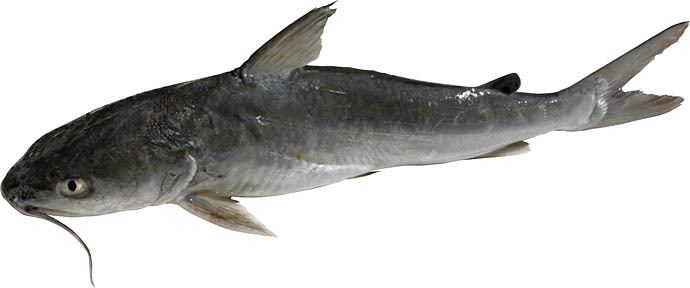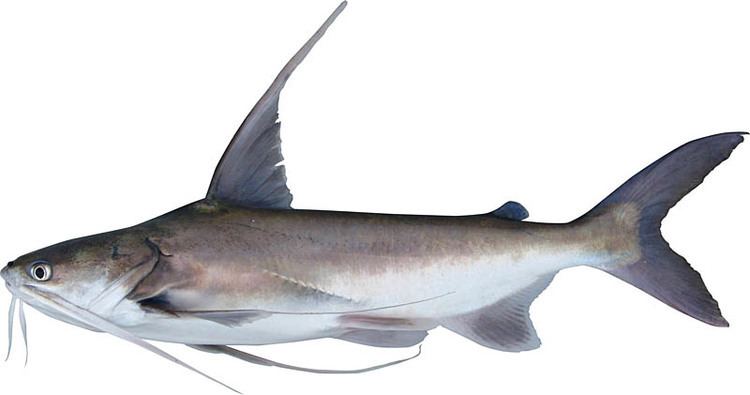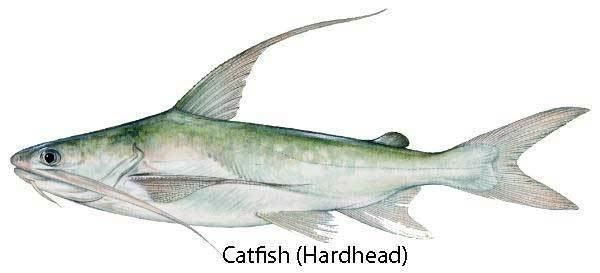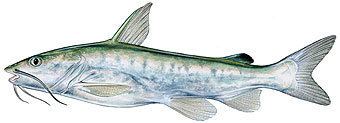Phylum Chordata Rank Species | Higher classification Ariopsis Order Catfish | |
 | ||
Similar Catfish, Gafftopsail catfish, Arius, Ariidae, Cynoscion arenarius | ||
Catch clean cook catfish fishing for saltwater catfish hardhead catfish how to cook catfish
The hardhead catfish (Ariopsis felis) is a species of sea catfish from the northwest Atlantic and Gulf of Mexico, and similar to the gafftopsail catfish (Bagre marinus). It is one of four species in the genus Ariopsis. The common name, hardhead catfish, is derived from the presence of a hard, bony plate extending rearward toward the dorsal fin from a line between the catfish's eyes. It is an elongate marine catfish that reaches up to 28 in (70 cm) in length and 12 lb (5.5 kg) in weight. The average weight is less than 1 lb (450 g), but they commonly reach up to 3 lb (1.4 kg). They are often a dirty gray color on top, with white undersides.
Contents
- Catch clean cook catfish fishing for saltwater catfish hardhead catfish how to cook catfish
- Habits distribution and characteristics
- Feeding behavior
- Locomotion
- Chemical
- Echolocation
- Sound production
- Life cycle and reproduction
- Mouthbrooding
- Advantages
- Fishing
- Weight and length
- References

Habits, distribution, and characteristics

Hardhead catfish are found mostly in the near shore waters of the Western Atlantic Ocean, around the southeast coast of the United States, around the Florida Keys and the coast of the Gulf of Mexico. Hardhead catfish are also found in brackish estuaries and river mouths where the bottom is sandy or muddy, but only occassionally enter freshwater. It tends to move from shallower to deeper waters in the winter months. The species is generally common to abundant within its range.

The hardhead catfish has four barbels under the chin, with two more at the corners of the mouth. These barbels help the catfish find crabs, fish and shrimp in the muddy bays where they live. The dorsal and pectoral fins each are supported by a sharp, slime-covered barbed spine. The dorsal spine is normally erect when the fish is excited and a tennis shoe or even a leather-soled shoe offers little protection. The gafftopsail catfish looks similar to the hardhead catfish, but its dorsal spine has a distinctive fleshy extension (like the fore-and-aft topsail of a ship).
Feeding behavior

Ariopsis felis consumes a wide range of food. Hardhead catfish are opportunistic consumers that use mud and sand flats as hunting grounds. They are also mainly secondary consumers, ingesting primarily detritus, meio-, and macrobenthic fauna and fish. Their diet primarily consists of algae, seagrasses, cnidarians, sea cucumbers, gastropods, polychaetes, shrimps, and crabs. They can occasionally be tertiary consumers. Their diet depends on their size and location. Younger hardhead catfish tend to eat small crustaceans, like amphipods, shrimp, blue crabs, mollusks, and annelids. Juveniles that are still under the protection of the male mouthbrooder will feed predominately on planktonic crustaceans close by to the mouth of the parent. The adults primarily consume larger fish.
Locomotion
Significant evidence suggests shows correlation between the fish's activity patterns and seasonal changes. Under controlled conditions of photoperiod, temperature, and water quality, hardhead catfish display non-random oscillations in angular orientation of locomotive activity. There appears to be annual, bimodal cycles for all three of the aforementioned variables. The cycles match with the seasonal inshore-offshore migrations of hardhead catfish. Photoperiod appears to be the exogenous cue that triggers the cyclic changes in behavior. The presence of this seasonal behavior indicates that there may exist a circadian neural mechanism in hardhead catfish.
Chemical

Studies show that hardhead catfish respond to chemicals released by injured individuals with increased activity, illustrating communication amongst catfish. Their activity level was highest right after the onset of the chemical stimulus. In the studies, they also responded to chemical cues from injured sailfin mollies, but this response was weaker than that of the response from their own species. After examining the epidermis of the hardhead catfish, it appeared that the alarm substance cells were similar to those of freshwater catfish. Prior to this study, these chemical responses had only been seen in freshwater ostariophysans. Hardhead catfish are the first marine ostariophysans to elicit this type of alarm reaction.
Echolocation
Furthermore, hardhead catfish are the first indicator that steichthyes possibly could use directional hearing to detect obstacles. Through observation, researchers noted that emissions of low-frequency sounds were related to the detection and avoidance of close by obstacles. Individuals within the group who produced sound avoided obstacles, whereas silent individuals crashed into obstacles frequently. Many fish have been associated with sound production for alarm, territorial, and courtship purposes, but sound probing of surroundings seems to be only be seen in hardhead catfish. So far, there is no evidence for far-field echolocation, such as seen in bats or toothed whales. The signal parameters have low frequency and amplitude, so it is unlikely that far-field reverberations would be useful. If echolocation exists, it is likely only useful in the near field by the catfish.
Sound production
There is some evidence that sound production in hardhead catfish is differentiated both mechanistically and contextually. Mechanistically, sound can be produced in a different ways. There are thin bones by the swim bladder that can be vibrated by specialized sonic muscles. Also, grinding of the pharyngeal teeth and rubbing of the pectoral spines against the pectoral girdle can produce sound. These two mechanisms appear to be evolved fright responses by the hardhead catfish. Some argue that hardhead catfish use an unrefined form of sonar as a means of echolocation, which also implies some directional hearing ability. It is possible, but insofar unproven, that sound is used in courtship and spawning.
Life cycle and reproduction
The hardhead catfish has a reproductive season from around May to September. Males and females reach sexual maturity before age 2. Females at maturity are around 12.6–26.5 cm (5.0–10.4 in), and males on average are slightly larger, typically at around 25 cm (9.8 in). At maturity, females develop flap-like fatty tissue by their pelvic fins, which results in them having larger pelvic fins than males. It has been suggested that these enhanced pelvic fins are the site of fertilization and that they play a part in moving the fertilized eggs to the male mouthbrooder for incubation. Another possibility is that males pick up eggs from depressions in the sand, as eggs tend to be demersal. They also die after 4 years.
Mouthbrooding
Like other members of the family Ariidae, hardhead catfish are paternal mouthbrooders. After spawning, the male will carry the eggs in his mouth until they hatch. There are several non-functioning eggs within the brood that attach to the larger, viable eggs. It has been speculated that these non-functioning eggs are used as food for the male mouthbrooder, since mouthbrooders do not feed while they are taking care of the brood. . Oral incubations continue through the yolk-sac larval state, for a total length of approximately 8–11 weeks. Under laboratory conditions, offspring can hatch in roughly 30 days. The offspring are roughly 6-8 centimeters long and slowly adapt to adult behavior, such as opportunistic bottom-feeding and scavenging. At absorption of the yolk sac, juveniles begin to show adult characteristics. The parental male can choose to carry the young after they have hatched until they are larger and capable of surviving on their own.
Advantages
There are many advantages to mouthbrooding as opposed to other forms of parental care, such as bubblenesting. Mouthbreeders are able to freely move with the eggs in their mouth, and thus, can move as necessary to protect both himself and the brood. Even though mouthbrooding requires more energy by the male, there is also a greater chance of his young surviving to adulthood, and therefore, reproducing and continuing his genes; the eggs are not defenseless while in their father’s mouth. Mouthbrooding by males counters the relatively low fecundity of females, who only have 20-65 eggs per spawning episode. Finally, through breathing, the male is able to keep the brood well oxygenated, which also increases brood survival.
Fishing
Hardhead catfish are voracious feeders and will bite on almost any natural bait. Hardhead catfish are also known to steal bait. Shrimp is a particularly effective bait to use. When fishing for this species in fresh water, assorted meats tend to work best as bait. For example: bacon, chicken, cuts of steak, and smaller fish. Hardhead catfish are generally regarded as an undesirable catch by most anglers, this may be largely due to the risk associated with handling the venomous fish as well as its 'fishy' taste as opposed to desirable game fish. A size 1 hook is usually effective for catching this fish. Anglers commonly use lightweight tackle if they are fishing specifically for this species, but many others use heavyweight tackle because the hardhead catfish seems to bite equally well on both. Care must be taken in handling hardhead catfish because the slime on their spines is mildly poisonous. If the skin is punctured, pain and swelling will ensue, and infection may set in. The spine is barbed, which makes withdrawal an even more unpleasant process.
Hardhead catfish are edible but, like all catfish, require some effort to clean. It is one of the thirty most recreationally harvested species in the 5-county area (Volusia, Brevard, Indian River, St. Lucie, Martin) encompassing the Indian River Lagoon (IRL)in central Florida. From 1997-2001, 361,022 hardhead catfish were harvested within 200 miles of the shore in the IRL region.
Hardhead are also harvested for industrial purposes in commercial bottom trawling operations. Annual harvests vary greatly, but from 1987–2001, 1.04 million pounds of marine catfishes (including both the hardhead catfish and the gafftopsail catfish) were harvested in the IRL region. The harvest was valued at $777,497.
Weight and length
Hardhead catfish weigh on average 1 lb (0.45 kg) and measure 10 to 12 in (25–30 cm) long.
As hardhead catfish grow longer, they increase in weight. The relationship between length and weight is not linear. The relationship between total length (L, in inches) and total weight (W, in pounds) for nearly all species of fish can be expressed by an equation of the form:
Invariably, b is close to 3.0 for all species, and c is a constant that varies among species. The relationship described in this section suggests that a 20 in (51 cm) hardhead catfish will weigh about 3 lb (1.4 kg), while a 25 in (64 cm) hardhead catfish will likely weigh at least 6 lb (2.7 kg).
